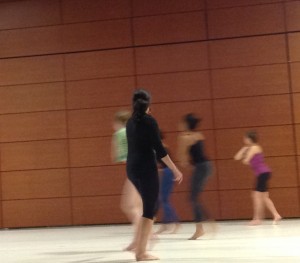On Jennifer Conley’s last day of rehearsing with the dancers at Bryn Mawr I had the opportunity to sit down with her to talk about the process of “Mawr Steps” from her perspective — including her experience as a reconstructor and her own relationship with Steps in the Street as both a teacher as well as a dancer.
I plan to post our transcribed conversation as a series of (loosely themed) excerpts. The following is the first of these!
…So, I’m thinking about the process of reconstructing a Graham work and you as a ‘certified reconstructor’—how are you trained to do that? That’s a good question. There’s no training.
Really? No, to be a regisseur with the Martha Graham Center is sort of an honor that’s bestowed on you—where there’s some kind of recognition that you’re capable of being articulate about the work, and capable of re-staging the work, because you’ve done the work. And you’ve done the work well. …Just because you’re a fantastic dancer doesn’t necessarily mean that you’re going to be really good with the learning exchange that has to happen in the studio. It just so happens that I’ve always really been interested in that learning exchange, I’ve felt at home in that place, and the more I did as a performer, the more I felt I had to offer in the studio.
And the work—when you’re learning the technique and teaching at the school, the technique is so codified …with these titles like “exercise on six twos” or “the deep stretches in fours” …But that’s kind of ironic because Martha herself never set out to create a technique. The technique was there to serve the movement she was creating, to serve her choreographic vision. And so when she first started they were doing a lot of walking, and a lot of falling and a lot of skipping.
And you have been instructed by the people who had that experience firsthand—so you are only ‘once removed’ from Martha herself? Absolutely.
The first day that we met you used the word “torchbearer”— I was wondering how you feel in terms of the privilege and the responsibility of carrying Graham’s legacy forward, and also how you’ve experienced this from your own teachers. There is a great responsibility, and it is a privilege and I am honored to be able to stage the work. To know that Mady [Cantor] contacts the Martha Graham Center and then the Martha Graham Center contacts me—that my name gets offered…
I don’t think of myself as a torchbearer. Pearl Lang, she danced in the company for 15 years, she danced a huge breadth of roles, she taught at the school for ages—I mean, when I engaged with her she was already in her 80’s, so there’s a certain—I reserve a certain level or stature in experience, in life experience, to be a torchbearer, so I may be a torchbearer in training—[laughing] I carry a very sturdy candle—
Because there is some unique role that you are playing, spreading the legacy— Yeah, absolutely, and there’s—I like the torch metaphor because you’re talking about igniting something in the minds and hearts of others. So that they can carry it on, illuminate something in their own lives in some way.
So from Day 1 I like to let people know that this work exists because of the chain of people who have continued to be interested in it. Otherwise it would have died with Martha when she passed away. It would have died with her when she stopped dancing if she could have had her way.
Right! Can you say a little more about that? She wasn’t interested in these old dances. This was the past to her and like most visionary artists they’re focused on the now and what’s next. So the effort to do these reconstructions of the dances from the 1930s really came about by those who were closest to her in the 1980s…
And [they were able to] bring in some of those [original Graham Group] dancers – like Anna Sokolow, Sophie Maslow, Jane Dudley – to sit there and say, “Well I remember doing it this way!” …”Well no it was never like this, it was like that!” …with body memories that are coming up from the 1930s, [dancers] who are remembering what it was like to dance this dance… 50 years earlier.
And that’s that historical lineage and fabric that we are now a part of—I’m a part of it, and now I’m working with you and now you’re a part of it too.


